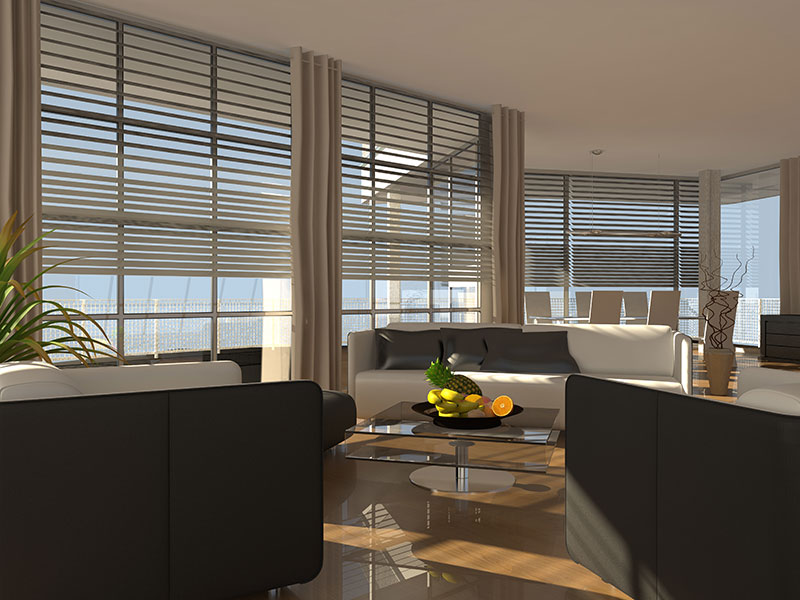There’s plenty to consider when choosing window coverings, including aesthetics, the balance between privacy and embracing the view, and optimising climate control and energy savings.
Because all window coverings perform slightly different tasks, there’s no single product that will be suited to every room in your home. When choosing curtains or blinds, a good starting point is to assess what their primary function will be and go from there – for example, do you need to keep out prying eyes, retain warmth during winter, or protect your interiors from the hot afternoon sun?

Following is an overview of the pros and cons of some popular window coverings, to help you make the right selections for each room in your home.
Roller blinds
Perennially popular, roller blinds are compact, cost-effective and easy to operate. Available in myriad fabrics, patterns and textures, they’re incredibly versatile in terms of both functionality and aesthetics. For bedrooms, you can choose a heavy-duty fabric that will effectively block unwanted light. In living areas, semi-translucent blinds reduce glare and allow you to enjoy your daytime views without anyone else being able to see in. (Bear in mind though, that translucent blinds will not offer any privacy at night, when you’ve got the lights on inside.)
One of the great things about roller blinds is that they virtually disappear when fully opened, for a completely unhampered view. If their sleek, slightly utilitarian appearance doesn’t suit your taste or your home, you can soften the look by layering them with fabric curtaining.
The insulating properties of roller blinds will depend on the weight of the fabric they’re made from (thicker fabrics will provide more protection), and how well they’ve been fitted to the windows. If there are spaces between them or air gaps at the side, air leakage will occur.
Good to know: If you have very wide windows, you may need two or more blinds to cover the span. The width of the roller mechanism creates a gap of several centimetres between each blind, which will compromise their light-blocking and thermal performance.
Venetian blinds
Venetian blinds are made from either timber or aluminium and are available in a range of colours and blade sizes. All varieties will elevate your interiors with their classic good looks. The main benefit of Venetians is that they offer an excellent balance between light control and privacy, depending on how you angle the blades.
Venetians are a great choice for those living in warmer climates. They work well to reduce heat gain, as the blades can be angled to shield the interiors from glare and sunlight. However, the gaps between the blades mean they don’t perform so well when it comes to protecting interiors from heat loss in winter.
Those tiny gaps between also mean that Venetians won’t completely block out light, so they’re most suited for use in bathrooms, laundries, kitchens and living areas, where darkness isn’t critical.
Slatted blinds will collect more dust than some other types of window coverings, and will need a regular going over with a vacuum cleaner or duster.
Good to know: When installed on very high windows, Venetians can become very bulky when fully raised, and will hang over the top section of glazing.
Top-down blinds
Top-down blinds are a relative newcomer to the window covering scene, but they offer plenty of advantages in the right applications. These innovative blinds are mounted on moveable rails fixed to the window frame and can be lowered from the top of the window and raised from the bottom. This allows you to let light in through the highest window panes, while maintaining privacy across the lower section; or you can adjust them to block sunshine without completely covering the window and your view. Genius.
These blinds can be made in light-filtering and blockout fabrics, depending on your requirements, and if the goal is to improve the room’s thermal performance, opt for the honeycomb (or cellular) varieties, which feature pockets of trapped air sandwiched between two layers of fabric to improve insulation and minimise heat transfer through the window.
Good to know: Top-down blinds operate cordlessly (unlike roller blinds and Venetian blinds), making them a safer option if children are around.
Curtains
Curtains are a flexible, easy and high-performance option for window coverings. Best suited to bedrooms, living and dining areas, curtains create a softer, cosier ambience than blinds and, because your choice of pattern and colour is almost limitless, they provide an opportunity to add some flair to your interior styling.
Curtains can be custom-made to suit almost any window. When paired with a thick, quality liner and overhead pelmet, they can dramatically improve the room’s overall insulation to help reduce your heating and cooling costs, and will effectively block light.
Ready-made curtains are a great option if you’re on a budget or need a quick-and-easy DIY solution. Unlike blinds, which must be accurately sized for the window frame, curtains can be hung to extend past the window if necessary. In terms of length, your curtains will look best if they are hemmed to finish at the windowsill or about 2cm above the floor.
Good to know: Curtains do require a bit of ongoing TLC. They may fade from exposure to sunlight, and because they attract dust, will need to be taken down and washed regularly.
Plantation shutters
A stylish and elegant option for rooms where privacy is essential (e.g. bedrooms facing the street), plantation shutters have wide slats that can be adjusted to let in light while ensuring no-one can see in and are also hinged so they can be pushed open to the sides of the window.
Plantation shutters are a great choice in warm climates because they can be left closed while the window is open, so you can enjoy the breeze and control light at the same time. They won’t flap about and rattle in the wind as lightweight, non-secured blinds do. Because they only need a wipe-down every now and then, plantation shutters are also a practical and elegant solution for bathrooms and laundries.
However, plantation shutters may not be the best choice in a room that doesn’t get much natural light. The wide frames block a lot of light and can make a room feel dark, even when the slats are set to open. When folded back, they create a lot of bulk at the sides of the window frame.
Good to know: While undeniably beautiful, plantation shutters are also more expensive than other types of window coverings, as they need to be custom-made to fit your windows, and are best installed by a professional.
Contact Smartline Rockingham mortgage advisers today to help you with financing options if you are planning to buy new window coverings for your home or property.

